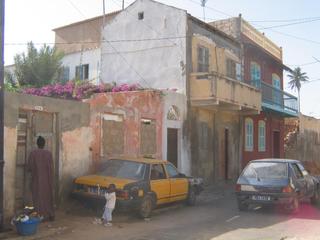St. Louis




At St. Louis, things got confusing and I ended up walking the wrong direction, then having the police arrange my taxi – who couldn’t find the place and still tried to charge me more than three times the going rate. But once on the island, all was forgotten and forgiven. A beautiful, chilly breeze was blowing off the water. The buildings were crumbling and colonial, with palm fronds and bougainvillea spilling out through gates and over stone fences. The downtown was lined with souvenir shops and restaurants and fancy hotels. The only difference between St. Louis and the Caribbean appears to be the mosques.
After checking into a gorgeous auberge covered in local art, I walked to find lunch at a place called “Le Fleuve,” which also had art on the walls. A plate of yassa chicken and a glass of lemonade later, the taxi brousse ride seemed miles away. I walked for a while, then found an Internet café and headed back tot he hotel for a snooze and some dinner, some rather gross and costly mafe with such strong, dirt-like peanut flavour I could barely choked it down. I think it was to do with the water, which is filtered but still tastes like dirt. As I was waiting for change, a Rasta named Teej came in and followed me on my walk, pointing out local haunts and good places for souvenirs. We headed back to the hotel, where he introduced me to Lupin, a French-Canadian and two Germans named Peter and Morris who had hooked up in Mauritania. Peter had spent four months in Maroc while Morris was trying to get to Egypt.
I flaked out early but was up early to walk the length of the island, which is really falling apart in the non-touristy areas. North of the bridge I ran into a woman with a baby on her back who was throwing out waste water and she invited me into her home. I fought my usual “Oh no, I couldn’t possibly” impulse and I’m glad I did. Khady turned out to be 29 and the baby on her back, Moctar, was her sixth child. We sat and chatted for a while and she told me her husband doesn’t work and immediately alarm bells started ringing, as this was a familiar story, one Grace had used to extract money. But it turned out she was just stating a fact. When her husband, Oussou, arrived, we chatted for a long, long time about Muslims and Islam and the teachings of the Koran and his six years in Koranic school, where he was beaten for failing to remember key passages. But it was all worth it, he swore, because now he spoke French, Wolof and Arabic and could do what he wanted when he wanted, and if thy needed anything, he would simply put together a prayer and ask Allah. That led to a discussion of gris-gris, something neither Khady nor Oussou believe in, which makes them unusual. Every Senegalais sports a gris-gris charm under their arm or around their waist, essentially a prayer written out asking for protection. Khady’s mom bought one for her children, but they don’t wear them. Instead, Oussou prays for them. I left them after several hours promising to return the next day so Oussou could take me shopping at his sister’s roadside “boutique.”
I rebuffed one souvenir seller, but stuck my head into the next shop, where some rough, folkish paintings caught my eye. The vendor was pleasant enough and we had a fabulous Ghana-style exchange which made me incredibly happy, as my French has clearly improved dramatically. The key, with everything here, is to go slowly. After about a half hour of discussions, I bought the painting for $20. Then I walked to a chawarma shop and ate the best sandwich I’ve had in a while and watched a montage on the late Pope. From there I headed to the Internet café, then back to the auberge to drop off my wrap and painting, then walked to the other island which is decidedly dirtier and rather neglected, touristically.

0 Comments:
Post a Comment
<< Home